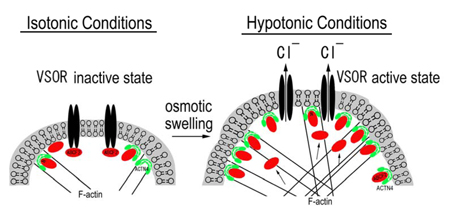Keeping cell volume constant is a fundamental function of animal cells to survive. After osmotic swelling, cell volume is recovered to its original one by a process of regulatory volume decrease (RVD) which is achieved by means of effluxes of KCl and osmotically obligated water. In the RVD process, the function of a volume-sensitive outwardly rectifying anion channel (VSOR) is known to be essential in most animal cell types. However, its molecular identity remains unknown and the information of molecular mechanisms which are responsible for RVD is limited. Therefore, we investigated the possibility that α-actinin-4 (ACTN4), an actin-binding protein, is involved in RVD on the basis of the previous reports that the cytoskeleton is involved in the regulation of RVD and of VSOR.
Here, we demonstrated that in human epithelial HEK293T cells, siRNA-mediated knockdown of endogenous expression of ACTN4 suppressed, whereas overexpression of ACTN4 enhanced, the process of RVD. We found that the content of ACTN4 increased in a 100,000×g pellet after osmotic cell swelling in a manner sensitive to pretreatment with cytochalasin D. We searched for a binding partner of ACTN4 by proteomics techniques and identified ABCF2, a cytosolic member of the ABC transporter superfamily, as an ACTN4-binding protein. Our results showed that the ACTN4-ABCF2 interaction, which requires the NH2-terminal region of ABCF2, is markedly enhanced by hypotonic stimulation in the presence of intact actin cytoskeletons. Also, overexpression of ABCF2 suppressed RVD by reducing whole-cell VSOR currents, whereas siRNA-mediated downregulation of ABCF2 facilitated RVD by augmenting the VSOR currents. Thus, our study showed that ABCF2 acts as a suppressor of VSOR as well as RVD and that a swelling-enhanced interaction between ACTN4 and ABCF2 prevents ABCF2 from suppressing VSOR activity and results in the facilitation of RVD, as schematically depicted in the Figure.
Y. Ando-Akatsuka, T. Shimizu, T. Numata & Y. Okada (2012) Involvements of the ABC protein ABCF2 and α-actinin-4 in regulation of cell volume and anion channels in human epithelial cells. J. Cell. Physiol. (Electronic version January 2012; doi: 10.1002/jcp.24050)
